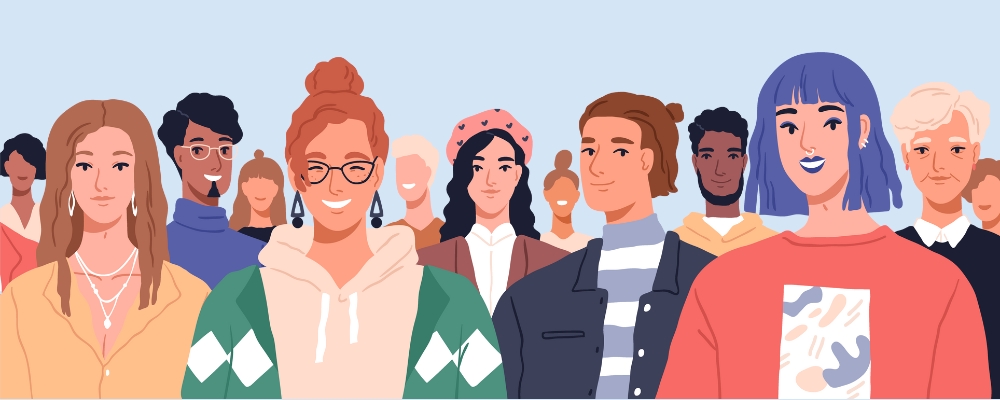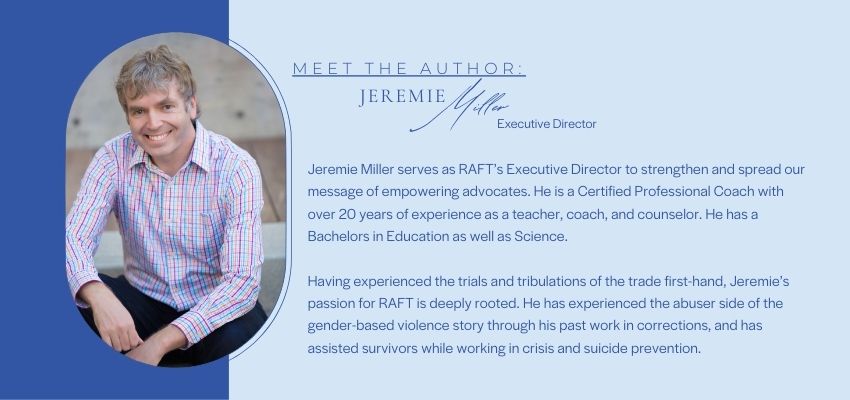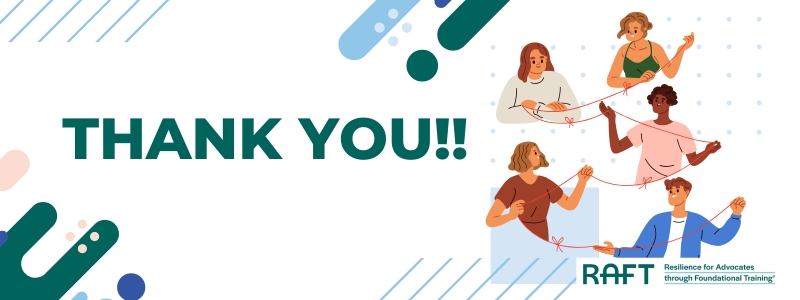7 Tools to Improve Connection and Community in Your Organization
Jeremie Miller, March 31, 2025
Since the re-election of Donald Tr*mp in November 2024, gender-based violence advocates have felt a growing heaviness. Now, three months into 2025, that weight has only intensified, and it feels as if we are struggling to catch our breath.
When times are heavy and overwhelming, it’s easy to retreat into isolation. However, isolation is not the answer. Now, more than ever, we need connection and community.
Connection, Not Disconnection is Needed
In "The Body Keeps the Score" Bessel van der Kolk writes, "Being able to feel safe with other people is probably the single most important aspect of mental health."
During times of crisis, connection and community offer essential support by:
- Reducing Overwhelm. When you are alone, you might need to shoulder everything on your own. When others are present, you can share that load and reduce the feeling that there is too much all at once.
- Sharing Your Strengths. None of us are great at doing everything, we all have our own unique strengths, and when we can utilize our strengths we are more successful. When we are in community we can depend not only on our own strengths, but on the strength of others to help us succeed.
- Validation of Your Experiences. When you’re alone you can feel like you are the only one experiencing the weight of what is happening right now. When surrounded by others you can share stories and realize that you are part of a larger group living a shared experience.
- Improving Your Problem Solving. One mind can approach a challenge with one set of experiences and one set of solutions. Many minds provide a wide variety of approaches to the problem and can help discover new answers.
- Sharing Energy. Trying to work on and solve every challenge that arises on your own is exhausting. In a community, when your energy wanes, there is someone else with more energy ready to step in and keep going.
- Providing Hope. In a community, when you run out of hope there is someone else who can still see the light and share that with you so you can keep going. Then later, when they falter, you can do the same.
These benefits help build resilience and growth, even in difficult times. To help with this, here are some of the tools that RAFT has been using to build and maintain our connection and community as a team, and with all of you.
Gratitude Practices
At the start of every RAFT meeting, team members share something they’re grateful for—an achievement, a person, or even something simple like a cup of coffee or the ray of sunshine through the window. This practice is straightforward: one person shares their gratitude and then selects the next person, continuing until everyone has participated. For large teams, breaking into smaller groups can help.
This simple habit shifts the tone of meetings and improves morale. Personally, I take this further by journaling three things I’m grateful for each morning, reflecting on the previous day. You can download a free morning journaling page with a gratitude section here: RAFT Gratitude Journal.

Co-working for Connection and Productivity
I love coworking. For years I’ve met virtually with friends to work together. We meet on Zoom (though you can do this in person as well) and each person shares their goal for the next ninety minutes. Then, at the end, we each give an update on what we achieved, what blocks we had, or how we got sidetracked. Even though we are working independently, there is a sense of community that helps with focus, and we get a lot more done.
At RAFT, we schedule optional coworking sessions. The organizer opens the Zoom room, and anyone on the team that is available and needs some company logs in and gets work done. Or team members will set a time to meet each other and work together on a specific project that requires multiple eyes. Regardless of the format, co-working fosters connection and productivity.
Communication Meetings
RAFT started communication meetings when we felt there was some "ick" building up around communication and team members. Now, we have realized that communication meetings are helpful even when there are no current "icky" feelings amongst the team.
Everyone in your organization is an individual and has unique communication patterns and expectations. Taking time to have a meeting specifically about each person uniqueness can improve your awareness of each other and improved your feelings of teamwork and belonging.
In a recent RAFT communication meeting we shared our "Manual of Me" slides (created by Sophie). Each "Manual of Me" slide shares a person's top strengths, values, communication style, Myers Briggs profile, intelligence type, and answers to a series of questions.
You can download and use the RAFT "Manual of Me" template slide here: ManualOfMe_Template
The Power of Transparency
Transparency between the people on your team builds trust and connection, but this is especially important for those of you in leadership positions. The people in your organization know that the chaos of 2025 is affecting your organization, and they want to know what is happening. Keeping your team in the dark isn't going to work, so getting started with being more transparent is important.
I won't say any more here, but you can read all about transparency with this list of blog posts (Link: You searched for transparency – Raft Cares)

Support Calls and Open Forums
Since the arrival of COVID-19, RAFT has held open support calls to discuss the pandemic, world events, Trump's re-election. Most recently, we held an open forum for advocates to gather to share stories and experiences about the start of 2025. The feedback on these open calls is always the same: advocates find it incredibly supportive to be in community with other advocates sharing the experiences they are having.
You can replicate support calls and open forums in your own organization by setting aside time for you and your colleagues to sit around the table and just talk about what is happening. You can leave these meetings completely open ended or pick a topic for discussion. The true power in these meetings isn't what is discussed, but that you have taken the time to listen, share, and support each other.
You can use the next tool to help facilitate these discussions…
Critical Awareness
RAFT teaches critical awareness as part of our five-workshop series, and we have used it a lot during our advocate support calls and leadership calls. Critical awareness is a three-step process:
- Normalize: Ask your group to talk about what they are experiencing right now. Then give each person a chance to share their own similar experience. As each person shares you start to eliminate that "it must only be me" feeling and feel yourself drawn into a community of people that are sharing your experience.
- Contextualize: The human brain tends to focus on the negative when it has a chance, contextualizing helps fight back against this. Ask your group to share all the amazing and great things that have been happening in the organization. Share your wins, what is working, and what you and your colleagues are best at. Contextualizing helps us look at the big picture and realize that, along with the stress and the bad, there is a lot of energy and good happening as well.
- Demistify: Finally take some time to explore why everyone is having the experience and what outside forces are causing them to feel the way they are feeling. This may be society in general, past expectations, people in their lives, cultural expectations, government, etc. Taking the time to explore the causes of the experience helps you to better understand the experiences you are having, and break down what you can control, and what is outside of your control.
Combining these three steps as an organization sheds light on what is happening and what everyone is feeling, and by the end of this exercise people will feel less lonely (normalized), see all the good they are doing (contextualize), and understand why they are having this experience (demystify).
Critical Awareness Example:
You decide to discuss losing funds due to one of your grants being frozen.
- Normalize: Someone shares that they are feeling like they are letting their clients down and abandoning them in their time of need. As you go around the room others share similar feelings and expand on the feelings. More people nod their heads as people share and a sense of common experience and connection builds.
- Contextualize: Someone shares a success in court, the grant writer found some emergency funding, a counsellor had an amazing session with a client, the new system for the supply room is working great, and some kids in shelter thanked the staff for all the help. Each of these stories of what is working gives energy to the group as you realize, even when things feel low, there are successes happening. You are doing important, good work.
- Demistify: Someone realizes that they have always been expected to fix everything that goes wrong in their family. Another person shares the latest executive order. Someone discusses rising prices. Someone asks if changing a certain policy in the organization would make things better. As the group discusses all of these you start to realize the factors that are out of your control, and the changes you can make.
Building Community with Appreciative Inquiry Questions
Appreciative Inquiry focuses on positive, strengths-based questions to highlight the best aspects of an organization and explore ways to enhance them. Use these prompts for journaling, one-on-one discussions, or team exercises:
- Describe one of your best experiences at your organization where you felt part of a community working together to achieve a common goal.
- What did you value about yourself in this story? What did you value about others in this story? What did you value about your organization in this story?
- What three wishes do you have that would improve the sense of connection and community in your organization?
- What small changes could you and your colleagues make to improve the feeling of connection, community, and support in your organization?
- What results would show you and your colleagues that these changes were successful?
Here are steps for using these questions as an activity at your next team meeting, or maybe you want to have an entire meeting and use these questions to focus on building community in your organization:
- Break into pairs and spend 30 minutes having each person interview their partner (15 minutes each)
- Move people into groups of 4 or 6 and have them share their partner's answers with the group.
- Have the group pick the top 3-5 themes of community they heard in the interviews.
- Have the group pick the top 3-5 small actions that could be taken to build community.
- Bring everyone together and have each group share their themes and small actions creating a big list for the organization.
- Pick one or two small actions that people can get started on. When those actions are finished, pick something else from your list.
(If this appreciative inquiry process sounds interesting you can contact outreach@raftcares.org and ask about our free appreciative inquiry facilitation opportunities)
Get Started on Building More Connection and Community Now
"In a world that can often feel unstable and uncertain, our relationships become the anchors that ground us. They remind us that even in the midst of upheaval, even when we feel undeniably lonely, anxious, or depressed, we are not alone."
- Esther Perel
I came across this quote in an email a couple of weeks ago, and it has been stuck in my head ever since. The start of 2025 has been tough for me, when I read this quote, I realized that I had been pulling away and isolating myself. I was working all day, feeling exhausted, and I was avoiding people outside my family because I didn't want to talk more about what is happening in the world.
This quote helped me to realize that isolation was one of the reasons I was struggling. I was missing the relationships that act as "the anchors that ground me." So, I have started reaching out to the RAFT team more to talk about things, and reaching out to the "right" people in my life that I know will understand me and support me.
Hopefully you can use some of the ideas in this list to discover, or rediscover some of these connection and community anchors in your own work and personal life.








